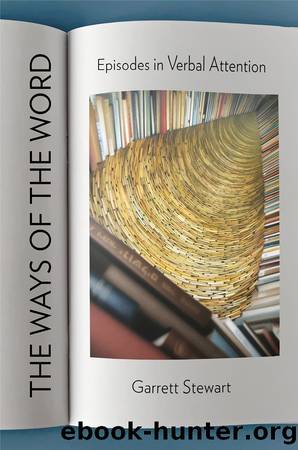The Ways of the Word by Garrett Stewart;

Author:Garrett Stewart;
Language: eng
Format: epub
Publisher: Lightning Source Inc. (Tier 3)
Published: 2021-06-15T00:00:00+00:00
Schooled by the Spool: Prose Montage
There is, to be sure, an internal build across these five chaptersânot just a parceling out of emphasis. Language on the literary page, in the passage from eye to the âpagingâ of an inner ear; literary speech on stageâso far so good: the start of a rough verbal anatomy in a survey of the wordâs audiovisual ways, subvocal against intoned. And now a third facet of the question, its perspective falling somewhere between alternate common definitions of the term âscreenedâ: sheltered, hidden, camouflaged, on the one hand; broadcast, projected, put out for display, on the other. On the lookout for prose cinematography when taking oneâs seat in front of a novelistic page, how exactly, in yet a further sense, does one âscreenâ for such features? In this comparative exploration, the work of screening is a sifting, a filtering. So this is a chapter about literary languageâscanned and sorted, winnowedâfor motion picture analogues. And vice versa, as inclination dictates: movies rerun in imagination in order to grasp some machinated equivalents (and rough models) in screen pacing for literary prose. With the result that, in a certain laboratory (or classroom) version of this chapterâs considerations, movies can be tightly surveyedâagain screened, sievedâfor âdiscursiveâ parallels. These intuited analogues in lexical or syntactic maneuver are formal counterparts best understood within a broad constellation of structuring increments and transitions in the shared narrative work of prose and motion picturesâcomplete with âgrammaticalâ compounding and subordination, with modifiers and amplifiers, appositions and antitheses, inertial sequence and reversalârather than narrowly construed according to the nonlinguistic codes of the editing shears per se.
One question above all drives these final two chapters: What is a cinematic sentence? No answer need be settled on in order eventually to have set a number of things straightâor at least to have set them going in an experimental mode of response. To begin with, the question of a cinematic prose soon devolves, productively enough, into discriminationsâwithin the very idea of imageâbetween the verbal metaphor and the photographic picture. And beyond that, the linguistic question is more pointedly syntactic. Soâeven with some likely contenders on record alreadyâone keeps asking whether there is something not just discernible, but generalizable, that one could call cinematic in sentence structure, which is to say in its montage of words? Not a question about some mode of filmic syntax organizing a narrative moment on screen: thatâs indisputable. But a cinematographic articulation in language alone? What balance of focus and velocity, of angle and frame, even of aspect ratios perhaps, may be experimented with by the pacing of prose that might call up the dynamics of our long-dominant narrative medium? Aside from the vistas wedged open by metaphor, what is it about the gait of grammar, its starts (either sense) and arrests, its ambivalent overlays and reloads, that keeps us going forward, even when its own motion may in certain narrative instances seem rotary, even ironically circular? What analogous relation, in short, does the word as
Download
This site does not store any files on its server. We only index and link to content provided by other sites. Please contact the content providers to delete copyright contents if any and email us, we'll remove relevant links or contents immediately.
| Ancient & Classical | Arthurian Romance |
| Beat Generation | Feminist |
| Gothic & Romantic | LGBT |
| Medieval | Modern |
| Modernism | Postmodernism |
| Renaissance | Shakespeare |
| Surrealism | Victorian |
4 3 2 1: A Novel by Paul Auster(11074)
The handmaid's tale by Margaret Atwood(6874)
Giovanni's Room by James Baldwin(5896)
Big Magic: Creative Living Beyond Fear by Elizabeth Gilbert(4734)
Asking the Right Questions: A Guide to Critical Thinking by M. Neil Browne & Stuart M. Keeley(4599)
On Writing A Memoir of the Craft by Stephen King(4221)
Ego Is the Enemy by Ryan Holiday(4000)
Ken Follett - World without end by Ken Follett(3981)
The Body: A Guide for Occupants by Bill Bryson(3815)
Bluets by Maggie Nelson(3722)
Adulting by Kelly Williams Brown(3681)
Guilty Pleasures by Laurell K Hamilton(3600)
Eat That Frog! by Brian Tracy(3525)
White Noise - A Novel by Don DeLillo(3443)
The Poetry of Pablo Neruda by Pablo Neruda(3371)
Alive: The Story of the Andes Survivors by Piers Paul Read(3320)
The Bookshop by Penelope Fitzgerald(3237)
The Book of Joy by Dalai Lama(3234)
Fingerprints of the Gods by Graham Hancock(3222)
